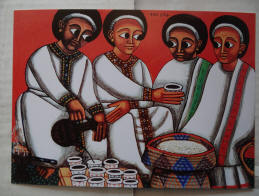Star Date: June 2015
Ethiopia IV – Hayk Lake, Mekele and Tigri churches
Come see us, in Bali, on You-tube – (An interview in English about our nomadic life; for a Russian journalist and audience). What fun to have this appear almost a year later on you-tube! Hope you enjoy it.
Как путешествовать по миру 25 лет? How to travel the world for 25 years?
Hello Dear Family & Friends!
“Ames segnalu”
(Thank you Amharic)

“We are very spontaneous – once in awhile we even combust.”
(Joseph Gill – my crazy travel partner)
We dropped off the face of the earth! If we had headed further into the Dekali Desert of Eastern Ethiopia we would have literally dropped over the edge. This desert depression is one of the lowest places on the planet, where Mother Earth forgot to finish her job! We pushed on. Too hot, dirty, remote – we’ll save that for the Sahara, of Northern Africa. Salt caravans transport the cherished salt blocks all the way to Mekele, where we bought a small amount in the crowded market. First they sawed some off a big block, then pounded it to crystals. Perfect for our cooking! We had hand gathered salt in Australia, South Africa and now Ethiopia. Fresh salt adds a rich flavor to any dish.
With such great distances to cover we chose interesting highlights off the tourist track. The tourist ‘Northern Circuit’ gets crammed especially during the Christmas high season. Luckily we were visiting not only during the low season but also during the vegan food fasting season! We jumped ship in Hayk Lake, north of Desse, immediately enjoying the different look of the super friendly Wolo people with camels in tow, and their unique half braided, half afro hairstyles. We spent a couple of nights along the lake in an authentic basic, bamboo round hut; hiking to the 627AD Istafanos Monastery, and just enjoying the scenery and abundant birds of “lake-lake” Hayk means lake, like the Gili Islands in Indonesia: Gili means islands: “island Islands”.
Ethiopia is a large country, the size of Kenya and Tanzania combined. With the infamous northern circuit in our sites we headed north: first walking, then in a bajat or ‘tuk tuk’ and finally a truck, mini van and land cruiser. What better way to start out adventure than hitching a ride with a St George’s beer semi truck and trailer carrying 4000 crates of beer? We crawled at a snails pace over the mountainous terrain but luckily our driver, Woytom, and his side kick were a pleasure to visit with. A self made man he had quit school at grade ten then proceeded to learn to be an electrician, a mechanic, and finally a professional driver at the University and now with the brewing company. He learns fast and has a strong work ethic. He offered us a beer but since it was only 9am we declined and he said he never drinks and drives, unlike many other drivers on long hauls. We enjoyed his company so much that we continued, free of charge, to the second town. I told them the long story of the Queen of Sheba I had just read as they beamed. Seems the Queen of Sheba, the legendary beauty from Ethiopia, had visited the palace of King Solomon. She returned ‘with child’ entwining the royal bloodlines. Ethiopians are so very proud of their heritage. It is obvious from the many beautiful Ethiopian women we saw, with their unique braided hairstyles, that the Queen of Sheba lives to this day!
Woytom declared that we was a “Happy man” so we had to play “Happy” by Pharrell Williams on my phone. And on and on it went making snail pace bearable, plus the view from way up in the cab was spectacular. He dropped us at the bus station in Woldia and continued up the road. Half and hour later we whizzed by him in a public mini van and waved and honked. He had only covered about 5 miles. Everyone laughed and waved and got in the spirit of things. In fact everywhere we travel people like a good joke or when we lighten things up. Smiles and laughter are a key to getting along and to enjoying life. We need to remember that more in the west, where pride, ego and stress dampen a fun moment. We can always be the bearers of a smile and share it with those around us.
We arrived into Mekele about 7pm and poor Woytom in his enormous truck arrived at noon the next day, but then that is what he does. He insisted that we meet at 3pm and after visiting the Mekele University, where we met his friend the Vice President. We proceeded down a dirt road into his village which was completely made out of stones and dirt. His family compound contained tiny stone houses with now tin roofs. Grandma, 92, Mom 55, sisters and brothers and their families, chickens, goats, dogs cats and kids all lived together in this wind swept environment. We were welcomed so warmly you would have thought that we had known each other for decades, rather than being a couple of a hitchhiking vagabonds by the side of the road.
Woytom, 33, and his wife Matera, 27, have 3 children, which he said is enough! They grew up in the dusty little village of Ainalum, perched high above Mekele. He has built his own home with a living room, one bedroom for 5, and a small side kitchen. They have all the luxuries that his salary provides, even a motorbike which he proudly drives while wearing a yellow construction hat. He has a heart of gold! The main thing they have is HAPPINESS in their simple life, something lost to many people regardless of their place in this interesting yet at times strange ‘human storyline’.
We were supposed to stop by the lively market, complete with chickens and camels, to pick up vegetables but as the day progressed this vanished in a flurry of stops. Luckily I had purchased a pack of spaghetti, a few tomatoes, three packs of cookies, and a box of ginger tea. At least 20 people and kids gathered in the small living room to have a look at us, supposedly the first ‘farenjis’ to visit the village ever. Woytom was so proud to have us visit that I thought his broad smile was going to burst at the seams! Woytom’s little 4 year old daughter stuck close to me while in the kitchen, holding my hand and eventually rubbing my skin quite hard to see if this white skin would rub down to black underneath. Grandma scolded her but I told her it was ok to be curious. They wanted to have us as their guests, and treated us royally, sharing whatever they had. Joseph played by ‘booing’ the little squealing kids and I set about learning how to make the infamous Ethiopian tomato sauce that is served with pasta, one of the only good leftovers of the brief Italian occupation. Actually tasty pizza in places has also miraculously survived. The secret ingredient of Matera’s sauce was her homegrown, dried and pounded chili powder, added at the end with oil. The electricity hadn’t blinked out but Woytom was ready with a new little solar light just in case. They were concerned about us getting home too late so away we went, well after dark, back down into town. He had called in a favor and his friend drove us down to town in his company car. We had a glow of contentment that had rubbed off on us, and we drifted off to sleep with visions of our new Ethiopian friends dancing in our heads.
After our enriching experience visiting Haramaya University, bouncing off the young energetic students and having Joseph lecture on the value of electronic text, we decided to visit the University in Mekele. Warmly welcomed, Joseph once again shared his knowledge of e-text with the University.
We enjoyed the camels of the Adi Haki Market , the terminus for the famous salt caravans from Danakil Depression. Merchants would saw off a hunk of salt or you could buy the already pounded salt by the kilo. The Danakil Depression is hailed as the hottest place on earth. Dipping to 116m below sea level this harsh area is basically uninhabited except for salt miners who carve up the vast salt lakes and nomadic Afar tribesmen. Thirty of Africa’s active volcanoes are in this region along with sulfur hot springs, lunar landscaped lava flows and orange bubbling lava lakes. Not only is the area inhospitable with 50 degree c temperatures and the infamous ‘Gara’ Fire Winds but in 2012, 6 tourists were killed and 4 kidnapped. The nomadic Afar people are fierce and as late as 1940’s had the disturbing custom of welcoming strangers by lopping off their testicles. Welcome to Danakil!
Our next adventure led us north with a jeep and driver to explore the hidden rock hewn churches of Tigrai. Carved from solid sandstone these well hidden gems were undiscovered until the 1960’s. Mystery surrounds the origins of the scores of hidden churches and still many are totally isolated and never visited by outsiders. The ones accessible by road and then a hike are lucky to see 2-3 visitors a week during the tourist season. Still working churches, these hidden edifices give off an aura of the unknown and spirituality seeps from their very core. As with many sights on our journey the surroundings of the churches were as magnificent as the church itself. Wukro Chirkos lies on the lazy outskirts of Wukro. We were greeted by a priest in a wheelchair and a nun in her finery, enjoying the morning under a large tree. Dating from the 4th century this church was draped inside by curtains and more curtains, some hiding paintings and others just lining the hand hewn cave. It is hard to imagine that these large rooms were carved chip by chip. That fact alone makes them remarkable. We joined a large celebration outside the main Orthodox church in Wukros. Drums were pounding, and people were all dressed in white swaying and singing. The serenity of Wukros Chirkos was immediately felt as only a gentle breeze rustled through the leaves of the giant sycamore trees. God likes a good party but seems to hang out in the peace and tranquility of Nature.
Heading towards Hawzien on a dusty, bumpy dirt road we were greeted by spectacular vistas and tiny villages. One such village hid a gem of Tigrai. Each church is still cared for by a robed priest with a white turban. Timing is everything as the large 12 ft high wooden doors are locked tight with large brass padlocks. Knowing we were pushing the revered Ethiopian lunch break of 12-2 we hiked up the stone stairs of Abreha we Atsbeha stone church. Regarded as one of the finest churches in Tigrai we started to reverently fool around with the old, half blind priest washing his feet in the courtyard. He laughed along and took a liking to us. I imagine things get pretty slow in such a remote area of Northern Ethiopia, and it made us think that not many people drop by for a visit. After paying our entrance fee he excitedly opened the massive doors and proudly showed us the very large carved interior 16m x 13m x 6m high. The intricately carved ceiling is supported by 13 pillars. Local tradition says that this church was carved in 335-40AD by the twin kings for whom it is named. Supposedly their mummified remains are hidden in a box in the Holy of Hollies. And legend has it the last priest who tried to open the box was severely burned. Many secrets are supposedly hidden behind closed doors in Ethiopian churches, but this one seems safe for the time being. Tradition also has it that Falasha Queen Yodit attacked the church burning one room and destroying a pillar. She became ill while ransacking the church and she made off with some sacred stones that emitted a supernatural light. Hours later she was hit with a heavenly gale that swept her to a spot outside Wukros (27km away) where she is buried under a rock. ‘Its not nice to mess with Mother Nature!’
The church was then abandoned until it was resurrected and a stunning mural was painted by King Yohanis IV in the 14th century, telling of the history of the Orthodox church. Quite an amazing surreal experience just us and the priest in this silent remote corner of Northern Ethiopia. Just think how many footfalls preceded ours across the threshold, polished smooth by those before us.
We turned to see another older priest enter the arch. His smile was so radiant that it was immediately contagious. He had just stopped by to grab a ram’s horn and a brightly decorated umbrella for the celebration in town. I realized later why he smiled so widely when he jumped in the back of our truck and got a ride to the nearest town. That saved him a good three hours walk. He blew his rams horn in appreciation! (And the walls came tumbling down……………..just kidding!)
And so it goes…………………………………..Next more treasures of Northern Ethiopia: hidden hand hewn churches, sacred ancient Orthodox monasteries of Lake Tana, glorious castles, 30 mt high stelae, and the supposed hiding place of the Ark of the Covenant. A land shrouded in mystery! Let’s remember to be spontaneous once in a while – even to the point of combustion! Take care and Keep in Touch
Love, Light & Laughter,
xoxoox Nancy & Joseph
Travel notes:
1 US Dollar equals 20.37 Ethiopian Birr
Hayk Lake:
Only one place to stay right on the lake- old but authentic huts. Logo Hayk Lodge (I think, maybe name changed, not sure) Kind of like camping. 300bir for ambiance and smoozing with locals. 200 meters down the shore a new place at Loko Haike Lodge is nearing completion but would be about 700 birr we were told by the workers
Mekele:
Hatse Yohannes Hotel: Try room #403 Good service, clean, former upscale, restaurant and also restaurant at Seti Hotel just down the street ‘Supermarket’ on the way. Near Palace, which was closed for renovations #0914 310937 230bir
Adi Haki Market – peoples fruit and vegetable market 5-10min walk from Hatse Yohannes

A friendly Orthodox Priest at an isolated Tigri hand
hewn church, in N.E. Ethiopia.

The inside walls of these ancient rock churches are
covered with bright religious iconic paintings.
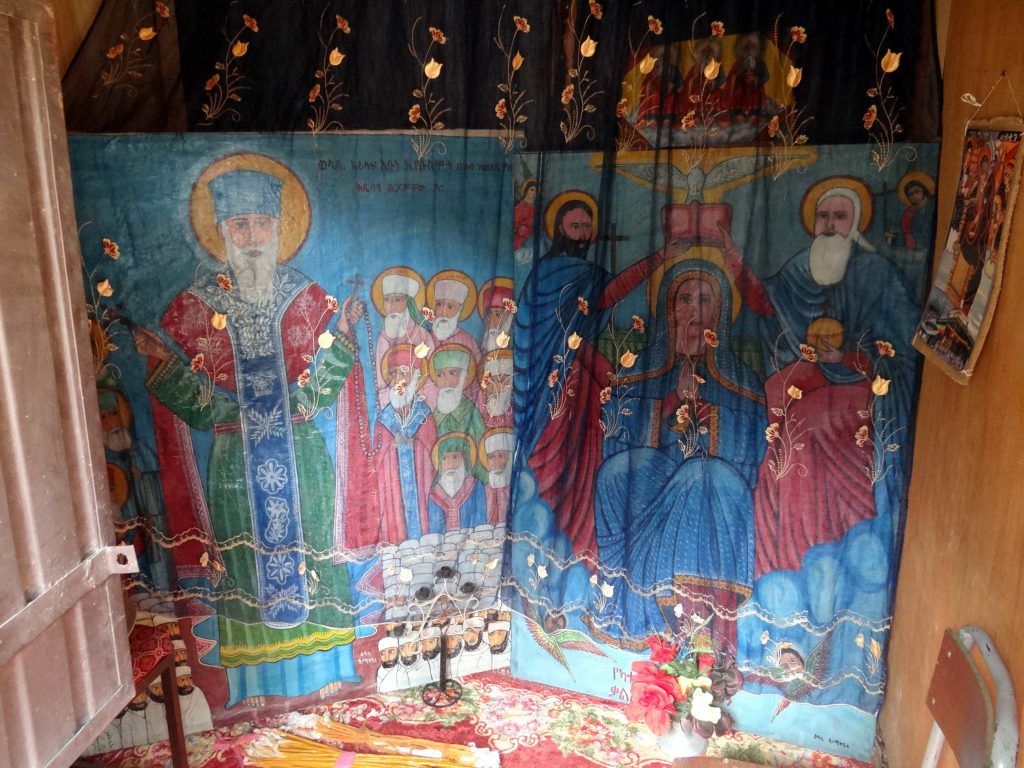
Sheltered from light for over 600 years these murals are still bright.

This priest proudly showed us his
Abreha we Atsbeha stone church.

Ceremonial crown over 700 years old.

The churches poke out of the sides of rock
ledges, hidden from outsiders for centuries.

Religious iconic art.

An old gentleman walking down the side of the road – at least
4 miles from any town or village.

Bright but not happy looking saints.
God likes when we are Happy!

A lively Orthodox celebration during Holy Week, including
drumming and singing and swaying.
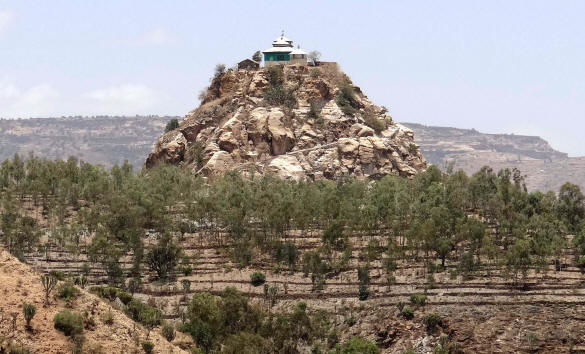
A monastery on top of a small mountain.

Isolated but stunning scenery between Wudros and Hazwien.

A fishing boat along Hayk Lake.
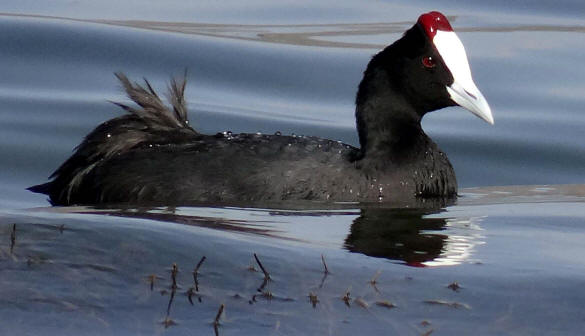
Hundreds of types of unique water fowl visit here.

Marabou storks up to 5 feet tall.

We nicknamed these birds ‘Kramer’ birds.

For those of you who are lacking in cultural information
this is ‘Kramer’ from “Seinfeld” comedy fame.

Inside our Wolo type hut along the shore.

Woytom’s St George’s Beer Semi Truck.

Although we traveled at a snail’s pace we enjoyed our time
hitchhiking in Woytom’s truck.

Stunning North Eastern mountains.
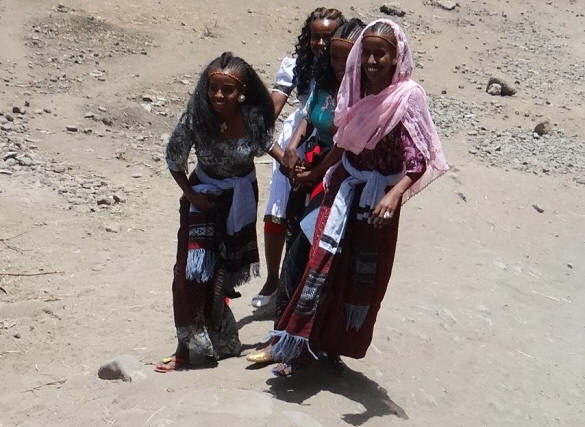
Beautiful Ethiopian woman walking beside the road.
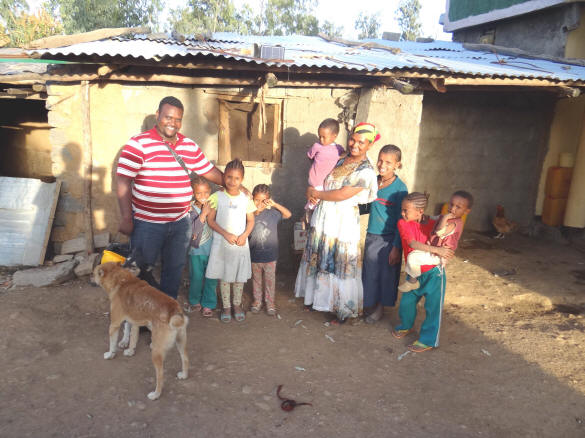
Woytom, 33, and his wife Matera, 27, have 3 children, which
he said is enough! In a small village there are always plenty
extra children playing in your house anyways!

Trying out Dad’s helmet.

Cutting our salt off a block with a saw.

Part of a camel caravan – possibly they were carrying salt
in from the desert.

Just resting and chewing!
.

Selling fresh roasted peanuts. Notice her interesting braided
hair.

Beauty salons posted photos of possible braiding designs-
fascinating what they could do with hair.

Cultural bead necklace and head piece.
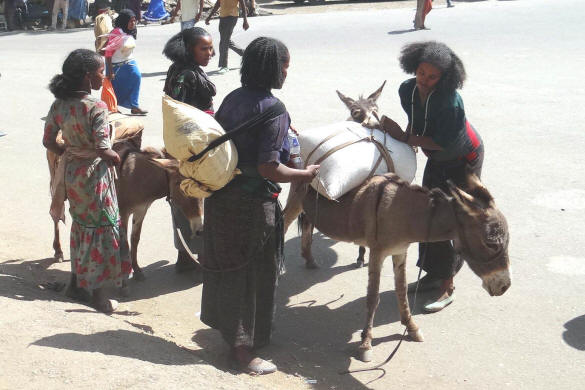
The Wolo women near Lake Hayk were busy in the market
with their donkeys and camels.

This page is dedicated to the beautiful Ethiopian women we
met, definitely descendents of the Queen of Sheba!

Unique Wolo hair style.
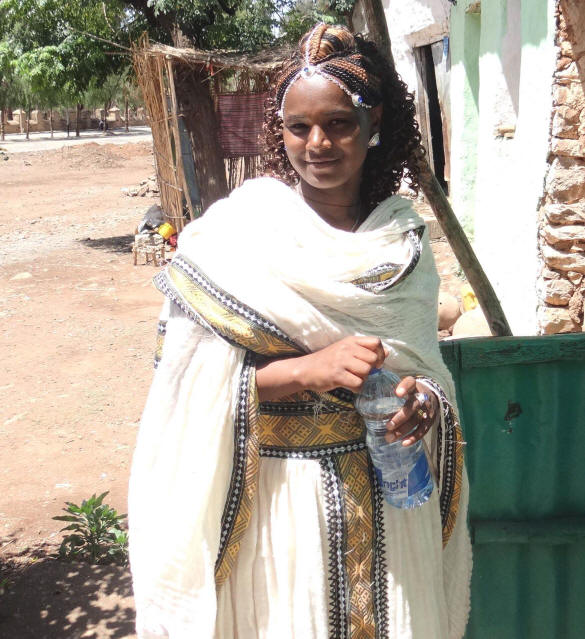
Another beauty out for a walk.

We were invited to a wedding.
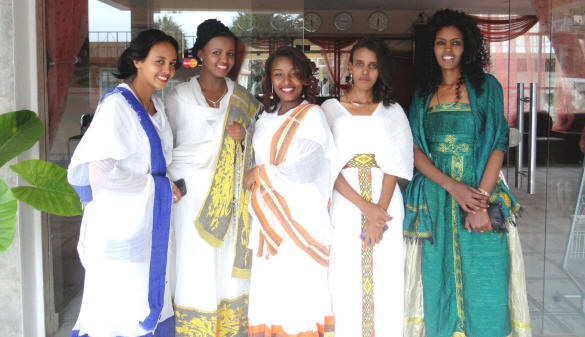
We met many pretty women all dolled up for the event.
Check out those smiles…………………
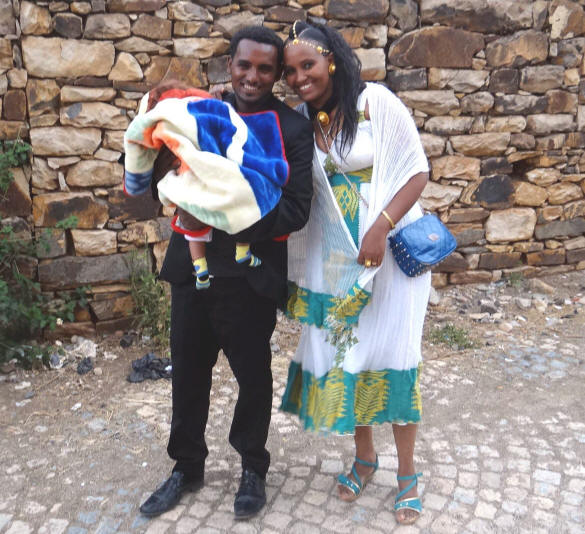
A happy couple off to the wedding………….
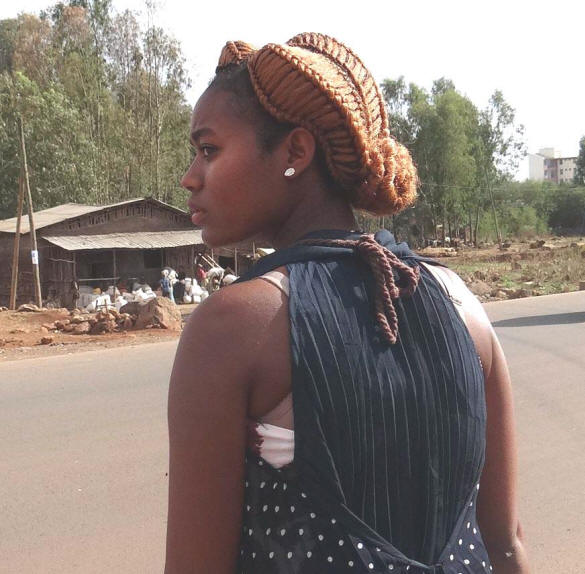
Another unique hair style.
.
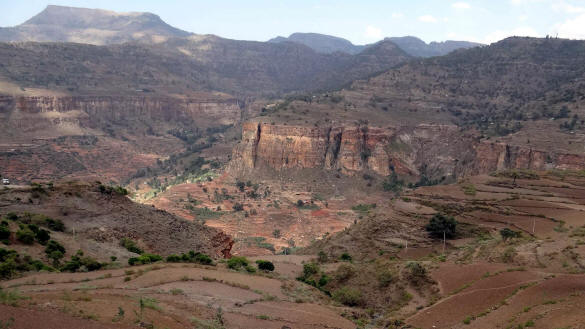
A magnificent canyon in N. E. Ethiopia.

Door men at our hotel. Their smiles were beaming but on top of
it they loved to stand and salute us
when we walked by. What fun!
